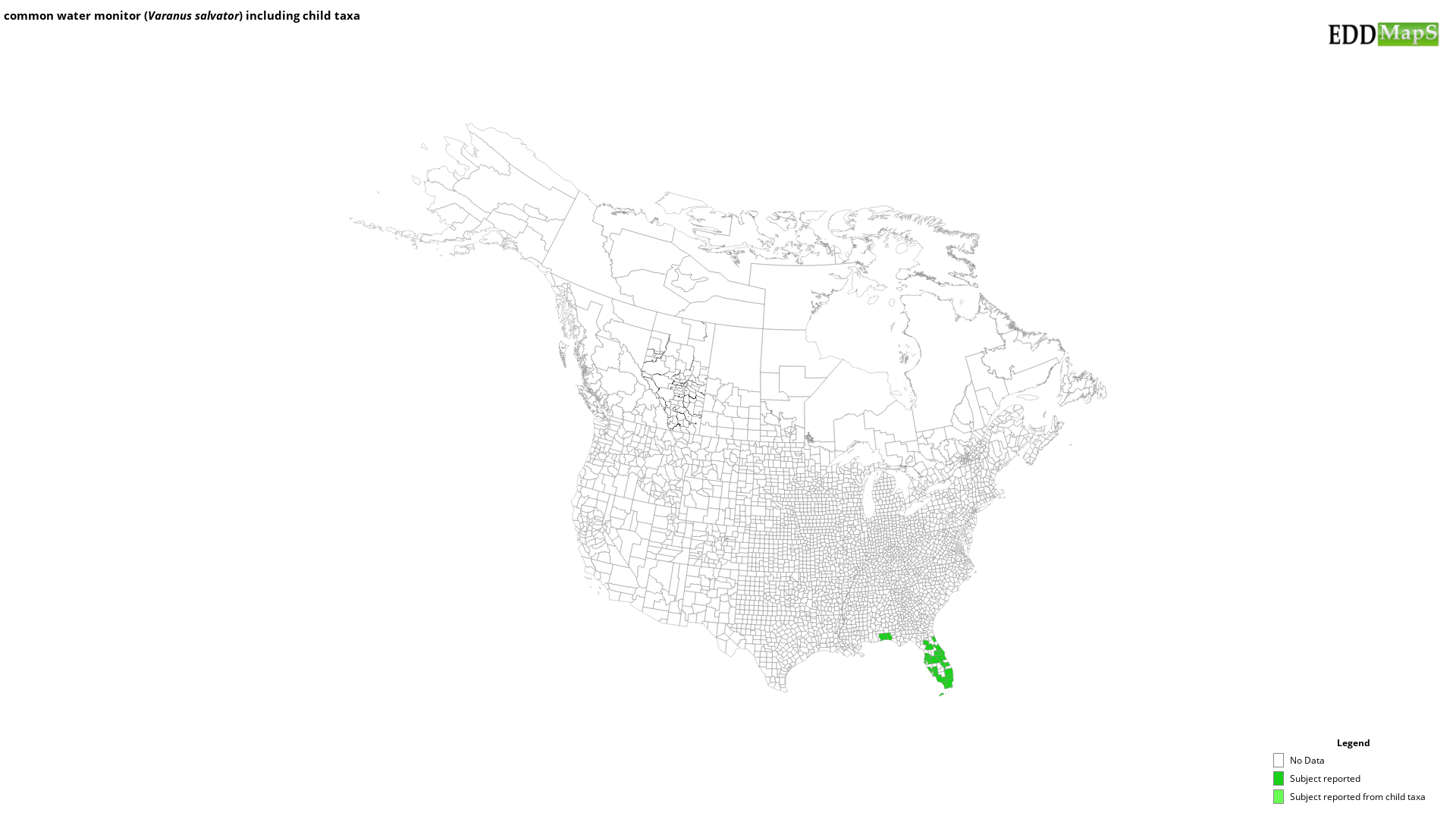common water monitor
(Varanus salvator)
This species is Introduced in the United States
Origin
Varanus salvator, common water monitor, is native throughout Southeast Asia. The introduction of this large and aggressive monitor to the United States is through the pet trade as released or escaped pets.
Life Cycle
Adults may reach sizes in excess of 8 ft (2.5 m) (Minton and Minton, 1973). Monitor coloration is primary dark olive in pigment with irregular pale yellow spots that appear in rows often diminish as the monitor matures (Cox et al. 1998). The neck of common water monitors is typically longer than the tapered head. The anatomical structure and size of this monitor differentiates it from all native United States lizards. V. salvator is a tropical, semiaquatic, omnicarnivorous predator that eats any invertebrate it can overpower. Males are typically larger than females. Adult females commonly bury eggs in a sheltered area including termite mounds, hollowed logs and stumps, and riverbanks. Typically long-lived, in captivity V. salvator have an average lifespan of 10.6 years.
Distribution
V. salvator has been reported in Arizona, California, Texas, and Florida.
Control Efforts
Due to the size and aggression of V. salvator, these monitors are potentially dangerous to humans. The impact of an established population on native wildlife would be negative. If a pet owner is unable to care for a V. salvator, contact a local pet shelter, agency, or pet store. Never release an unwanted pet into the ecosystem.
Minton, S. A., Jr., and M. R. Minton. 1973. Giant Reptiles. Charles Scribner’s Sons, New York. 345 pp.
Cox, M. J., P. P. van Dijk, J. Nabhitabhata, and K. Thirakhupt. 1998. A Photographic Guide to Snakes and Other Reptiles of Peninsular Malaysia, Singapore and Thailand. New Holland Publishers (UK) Ltd, London. 144 pp.
Varanus salvator, common water monitor, is native throughout Southeast Asia. The introduction of this large and aggressive monitor to the United States is through the pet trade as released or escaped pets.
Life Cycle
Adults may reach sizes in excess of 8 ft (2.5 m) (Minton and Minton, 1973). Monitor coloration is primary dark olive in pigment with irregular pale yellow spots that appear in rows often diminish as the monitor matures (Cox et al. 1998). The neck of common water monitors is typically longer than the tapered head. The anatomical structure and size of this monitor differentiates it from all native United States lizards. V. salvator is a tropical, semiaquatic, omnicarnivorous predator that eats any invertebrate it can overpower. Males are typically larger than females. Adult females commonly bury eggs in a sheltered area including termite mounds, hollowed logs and stumps, and riverbanks. Typically long-lived, in captivity V. salvator have an average lifespan of 10.6 years.
Distribution
V. salvator has been reported in Arizona, California, Texas, and Florida.
Control Efforts
Due to the size and aggression of V. salvator, these monitors are potentially dangerous to humans. The impact of an established population on native wildlife would be negative. If a pet owner is unable to care for a V. salvator, contact a local pet shelter, agency, or pet store. Never release an unwanted pet into the ecosystem.
Minton, S. A., Jr., and M. R. Minton. 1973. Giant Reptiles. Charles Scribner’s Sons, New York. 345 pp.
Cox, M. J., P. P. van Dijk, J. Nabhitabhata, and K. Thirakhupt. 1998. A Photographic Guide to Snakes and Other Reptiles of Peninsular Malaysia, Singapore and Thailand. New Holland Publishers (UK) Ltd, London. 144 pp.
Resources
- Wikipedia - Wikimedia Foundation, Inc
- Nonindigenous Aquatic Species Database - U.S. Geological Survey
- Animal Diversity Web - University of Michigan Museum of Zoology
Selected Images
Maps
EDDMapS Distribution - This map is incomplete and is based only on current site and county level reports made by experts, herbaria, and literature. For more information, visit www.eddmaps.org
State Lists - This map identifies those states that have this species on their invasive species list or law.
Invasive Listing Sources
Taxonomic Rank
| Domain: Eukarya |
| Kingdom: Animalia |
| Phylum: Chordata |
| Class: Reptilia |
| Order: Squamata |
| Suborder: Anguimorpha |
| Infraorder: Paleoanguimorpha |
| Superfamily: Varanoidea |
| Family: Varanidae |
| Genus: Varanus |
| Varanus salvator |
References
Common Name Reference: Integrated Taxonomic Information System on-line database.
Scientific Name Reference: Integrated Taxonomic Information System on-line database.


